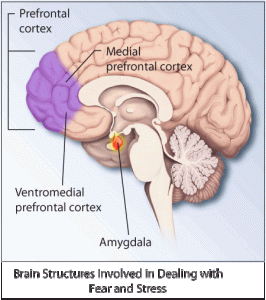Imagine it’s a hot day and you are standing on the edge of dock, looking down into the cool water below. You want to jump in, but you are suddenly overcome with terror at the thought of being in the water; your heart starts racing, you can barely breathe, you start sweating, and your first instinct is to run back to the safety of shore. This unreasonable fear you have in response to water is likely a phobia, aquaphobia to be exact. Phobias are an extreme and irrational fear when exposed to some specific stimulus like insects, heights, or water. Interestingly, those who suffer from phobias recognize their fear is irrational and there is no real threat of danger, yet they will still avoid any contact with their phobic trigger. This begs the questions, what causes phobias? And what is going on in the brain to cause such extreme reactions to often innocuous objects or situations? With somewhere between 5-13% of Americans experiencing a type of phobia at some point in their lives, the neurological basis of phobias and fear is certainly worth investigating. Here are some of the most common types of phobia that are encountered:

According to the DSM-IV, there are 4 categories of phobic stimuli; animal, situational, blood injury, and nature-environment. The cause of different types of phobias is still debated though. One well proven theory is that phobias develop as a result of an unpleasant or traumatic experience in childhood. For example, if a child had an unpleasant experience in a confined space, they may develop claustrophobia. Additionally, a child may witness a family member’s phobia and develop the same phobia. Still, it cannot explain how agoraphobia or social phobia arises; the causes of these are still somewhat of a mystery. Some researchers believe the disorder could be a combination of life experience, brain chemistry, and genetics.
So now we have established that one likely cause of phobia is conditioned fear; it is learned through a family member or through a traumatic experience. So what is going on in the brain during this extreme fear response? A lot of what happens has to do with the amygdala, which triggers the release of “fight or flight” hormones as well as areas in the frontal lobes. The anterior cingulate cortex and the medial prefrontal cortex have been shown to be involved in processing and responding to negative stimuli while the ventromedial prefrontal cortex monitors the amygdala’s response to emotional stimuli or fear. However, in patients suffering from a phobia, these areas appear to function improperly. Here is a map of some of the areas involved:

So, rather than being a system sensitive only to harmful stimuli, the improperly functioning circuits create a fear response to neutral stimuli. As a result, when somebody with a phobia encounters their phobic trigger, the activity in their amygdala spikes. A full on fight or flight reaction occurs even if the stimuli is relatively neutral and harmless.
Want to know more about phobias and the neuroscience of fear? Check out this video!
Sources:
Stein, M. B., Goldin, P. R., Sareen, J., Zorrilla, L. T. E., & Brown, G. G. (2002). Increased amygdala activation to angry and contemptuous faces in generalized social phobia. Archives of general psychiatry, 59(11), 1027-1034.
Larson, C. L., Schaefer, H. S., Siegle, G. J., Jackson, C. A., Anderle, M. J., & Davidson, R. J. (2006). Fear is fast in phobic individuals: amygdala activation in response to fear-relevant stimuli. Biological psychiatry, 60(4), 410-417.
http://www.medicalnewstoday.com/articles/249347.php
http://brainblogger.com/2010/04/22/the-neurobiology-of-social-anxiety-disorder/
Filed under: psychology & neuroscience Tagged: amygdala, fear, flight or fight, phobia












